Music with twists and turns: There’s more to a pipe organ than meets the eye
This article was first published in 2017.
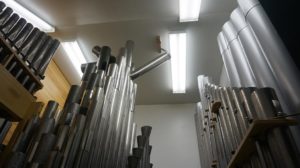
The tall straight organ pipes visible behind the chancel in Central Presbyterian Church, Geneseo, New York offered a deceptively small glimpse at the majesty and inner workings of the congregation’s organ. Being naïve about such things made for an enlightening and delightful introduction to pipe organs, offered kindly by the church’s musical director, Dave Hurd. Hurd has been at Central Presbyterian for thirty-one years, having transferred from a church that had a “pretty nice organ.” Hurd was instrumental in the installment of a larger, updated organ at Central Presbyterian, to replace the 1950’s Möller that was in the church when he took over musical directorship in 1986, although it was seventeen years before his vision became a reality.
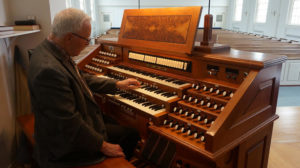
Removed on Ash Wednesday in 2002, the older organ, a 1950 M. P. Möller Opus 8126, was “given up for Lent.” The congregation decided on a Parsons Opus 17 for their replacement organ, built by The Parsons Organ Company in Bristol, NY. The Parsons Organ Company was founded in 1954, a continuing tradition in organ-making expertise that began in the late 1800’s, when Gideon Levi Parsons apprenticed with noted organ builder, John Wesley Steere. As with all sacrifices, the installment of the new organ was not a simple matter and meant being without an organ for a period of time. Considerably larger than the previous instrument, the Parsons’ organ required both an enlarged chamber and enlargement of the church’s chancel to accommodate accompanying instruments. The organ console and the pulpit are now movable; the area can accommodate an entire string orchestra.
Hurd’s discussion of the installment of the new organ provided me some rudimentary organ vocabulary (pipes, ranks, flutes, chamber) and initiated my brief introduction to the complex functions and fanciful inner workings of pipe organs. Organs, unlike their somewhat look-alike, the piano, are not string keyboard instruments. Rather than striking a hammer against a string, the sound, instead, comes from pressurized air, “wind,” that is directed to a selected pipe(s) using the keyboard. The more pipes, the greater the range. The pipes are arranged in sets, “ranks,” that have common timbre and volume along the keyboard compass (range). The Möller had eleven ranks (rows of pipes); the Parsons’ has thirty-eight (including most of the pipes from the earlier instrument). The Möller had 793 pipes, whereas the Parsons has 2300, or so.
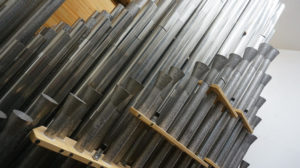
With so many more pipes, finding the room to fit the organ into the existing chamber space required some creative modifications. Standing in the nave of the church looking toward the chancel, I counted only thirty-one pipes. Seeing the other pipes, the organ itself, required a climb up fold-down attic stairs, into the chamber, behind the casework façade visible from the nave. Standing next to the organ’s network of pipes, I peered out through the slats that carry the sound from the chamber to the ears of the audience on the other side. This inner chamber seemed a sacred place, as I marveled at the assemblage of pipes all around me I felt that a door to a wonderland had opened – a wonderland beyond comprehension.
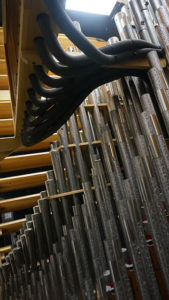
After walking past a long wooden box, the air channel that fed the air from the console to the pipes, I moved into a small room that held a complex wooden framework supporting rows and rows of pipes, some of which had to be twisted and turned to fit, others as small as a common water pipe. The pipes, arranged in ranks – sets of pipes that share pitch levels, each provide a single note/pitch/key on the manual or pedal keyboards. A single rank on a 61-note keyboard has a corresponding sixty-one pipes in graduated lengths. Smaller pipes have higher pitches. There are four types of pipes: flue, flutes, reeds and strings, the flues being the only pipes creating sounds unique to pipe organs.
Returning to the chancel area, Hurd settled in at the console (described by Parsons Organ Company as the “ organist’s interface with the instrument”) and explained to me some of the complexities of what, despite a slightly increased level in knowledge, had only continued to build in mystic and awe. Hurd demonstrated some of the range of sounds that are possible and discussed some of the console components. More pipes require a larger (and more complex) console to accommodate the greater variation of sounds.
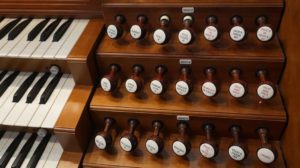
The Möller had two manuals (that is keyboards) on the console, the Parsons organ, in comparison, has three. It also has an increased number of “stops,” buttons and pedals that direct the air to various pipes. Stops are the tools that an experienced organist uses to make musical magic happen. Like a rank, a stop (register) consists of a set of pipes, one or multiple ranks. For each of the ranks a stop includes, that many pipes will open. If there are five ranks included then five distinct sounds – all tuned to the same note – will be heard when a key is depressed.
The earliest pipe organs used hydraulic pressure — a system of piped water – and bellows, requiring operators to run the system while musicians performed. Newer electric blowers have eliminated that need. Most modern organs are electro-pneumatic, and are operated by a combination or air pressure, that opens and closes the pipes, and electric circuits that feed the information to the system from the keys. With the electric system that the Opus 17 has (as opposed to older mechanical keyboard/valve systems), the amount of pressure or speed at which the keys are depressed does not change the sound. The organist’s proficiency at operating the various stops and pedals are what provides variation in volume and tone.
Described by some as the most complex of musical instruments developed prior to the industrial revolutions, in watching Dave Hurd at the console I had to agree. I was reminded of a musician I have been listening to some recently, Tash Sultana. Described on her site as a “Melbourne based, self taught, singer, songwriter, beat boxing, vocalist, guitar tapping loopologist,” Sultana uses an expanding array of pedals to change her sound, transforming her voice and guitar into something more. In theory perhaps the underlying ideas behind pipe organs are not so complex, but the possible combinations allow for endless variation and innovations.
The organ assumes an ongoing and prominent role in the church, providing musical accompaniment for weekly hymnals as well as weddings and periodic community concerts. The Central Presbyterian Church also hosts a yearly Organ Recital Series to allow top organists to use and perform on the organ. Performances are at 31 Center Street, Geneseo. The performances are free and open to the community.
Editor’s Note: David Hurd has retired from the church since the writing of this article; the new organist and music director is Andrew Van Varick.